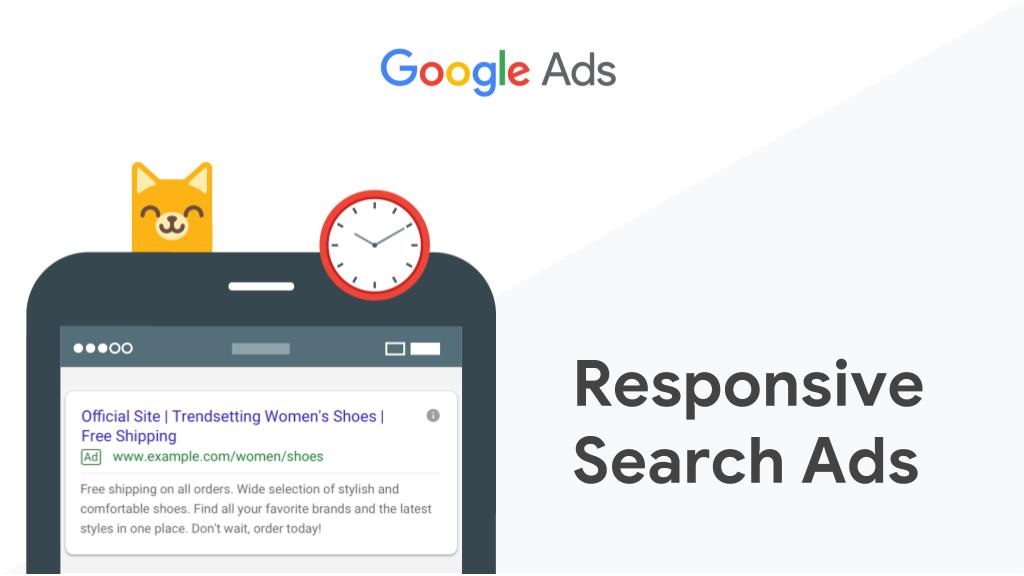Responsive Text Ads will now be the default ad type created in Google Ads. Advertisers can still create new Expanded Text Ads and edit existing ones.
What does this mean for advertisers and Google Ads moving forward? In this post, we’re going to:
- Clarify what’s changing for advertisers.
- Compare RSAs to the former default ad type (Expanded Text Ads).
- Walk you through how to set up RSAs.
- Share input, tips, and best practices from the PPC community.
Our hope is to help you to better understand and adapt to this change so your ads can keep performing their best.
What does this change mean?
The change in default ad type from Expanded Text Ads (ETAs) to Responsive Search Ads (RSAs) means that when you click to make a new ad, there are now only two options: Responsive Search Ads or Call Ads.
This doesn’t mean that Expanded Text Ads (ETAs) are completely going away (at least not yet—more on that later) or that your ETAs are all of a sudden going to stop performing. On the contrary, having two ETAs and one RSAs per ad group still remains the recommended best practice by Google.
ETAs will still be an option to create as well, though it is a bit hidden. You’ll have to click to create an RSA, and then click the blue text at the top to “Switch back to text ads” in order to continue creating ETAs. So, this change does indicate to us that RSAs have now taken the seat on Google’s throne of the default Search ad type.
What Are Responsive Search Ads?
Traditionally, text ads in Google were comprised of headlines and body copy. The advertiser would write them in the intended order.
Multiple, stand-alone versions would be created, with Google rotating the versions against each other. How it does so is determined by the advertiser in a Campaign’s settings:

Responsive Search Ads change this original dynamic a bit.
Instead of each ad being viewed as its own version, each piece of the ad is viewed as an “asset.” These assets are then mixed and matched by Google to find the best combination of headlines and body copy for a campaign’s goal.
The setup looks like this:

Responsive search ads are noted as that type in the Ads section, and also have a link to “view asset details” for advertisers to see all the assets running in that RSA:

The pros and cons of RSAs
By dynamically cycling through headlines and descriptions, RSAs clearly have different features and capabilities that set them apart from ETAs. However, like we just mentioned, all that glitters is not gold when it comes to RSAs, as their variety also causes a lack of control in ad copy and their expansive nature may cause you to carve out a little extra time to create these.
While you may be able to whip up an ETA in no time with just a couple of descriptions and few headlines (while avoiding these mistakes), we’ve noticed that RSAs take a bit more time to complete since you have to come up with many more lines of copy. Luckily, Google helps us out by providing suggestions when we’re creating these ads.
You do have a pin option for RSAs for up to three headlines and two descriptions. Here, you can choose a specific headline or description to be guaranteed to show when space on the SERP allows. However, pinning isn’t recommended unless absolutely necessary, as it will restrict the automatic variant testing Google runs through on your Responsive Search Ads.
Here’s a quick pros and cons list to sum up what we’ve learned about RSAs so far:

How to set up and optimize your Responsive Search Ads
Okay, so you’ve read through everything and now you’re ready to set these ads up. Here’s the step-by-step on how to create a Responsive Search Ad:
- Select the ad group you wish to build out and click the blue plus button to create an RSA.
- Fill in the final landing page URL.
- Complete the path fields for a Display URL.
- Fill in all 15 headlines ( up to 30 characters).
- Fill in all descriptions (up to 90 characters).
- Hit save.

Seems easy peasy, right? Well, we’d like to think so, but there are also a few dos and don’ts of RSAs that you’ll want to keep top-of-mind while creating them.
RSA do’s (best practices)
- Include three to five ads per ad group with at least 1 RSA.
- Fill out every single portion of the ad (all fifteen headlines and all four descriptions whenever possible).
- Include top-performing keywords in your ad copy.
- Freshen ad copy regularly so viewers have something new to look at.
- Capitalize the first letter of each word in your copy.
- Leverage Dynamic Keyword Insertion.
- Leverage Ad Extensions.
- Take advantage of the shuffled previews Google displays for you on the bottom right of the screen to see what your ad will look like.
RSA don’ts (what to avoid)
- Keyword stuffing (Don’t throw keywords in just for the sake of including keywords in your copy if it doesn’t make sense).
- Mismatch headlines/descriptions (Make sure your copy is cohesive, so ask yourself “Would these headlines/descriptions go together if they were just shown alone?”).
- Pin three headlines and two descriptions—that defeats the purpose of RSAs!
- Use repetitive wording.
How to respond to the change
We talked to additional PPC experts in the community to gather some perspectives and action steps to help you respond to this change. These include Mark Irvine, Director of Paid Media at Search Labs Digital, and Brett McHale, founder of Empiric, LLC.
Leverage RSAs to regularly test out a diverse mix of messages
Irvine points out that “the fundamental problem that Google is trying to solve here is not a new challenge to the industry—advertisers should be constantly updating and testing multiple versions of their ads. Although this is an age-old best practice, a lot of advertisers don’t commit to it regularly and their accounts suffer for it.
Ad copy testing not only helps advertisers improve their ads overall, but it also allows Google (and Bing and Facebook) to better match a message to a particular search or user. Constantly creating three plus ads in each ad group just isn’t a habit for some advertisers, and Google’s Responsive Search Ad type picks up the slack there. In lieu of asking advertisers to write multiple variants of their ads, RSAs automatically take their headlines and descriptions and test out a more diverse mix of messages for the advertiser.”
Continue creating and testing ETAs
While the emphasis on RSAs can encourage more testing and better ads overall, Irvine advises advertisers to continue creating ETAs while using RSAs as a supplement:
“RSAs are a better testing mechanism than not testing at all, but it shouldn’t surprise people to hear that a “handwritten” ad can often outperform Google’s machine-written variants. Google’s change to default ad creation to RSAs is a bold one to encourage their adoption, especially among novice advertisers who might not understand the difference. Overall, I’d encourage advertisers to supplement their ad groups with Responsive Search Ads but to continue to test two to three ETAs in each ad group. This will both allow you to continue to practice and optimize your ad copy while benefiting from Google’s machine learning-driven ad copy testing at scale.

Why the switch?
Google provides a few reasons for the change in the default ad type from ETAs to RSAs:
Machine learning allows for improved performance
We’ve seen a pattern emerge with Google’s recent updates in favor of a shift toward automation. While many advertisers feel this gives them less control over their campaigns, Google takes the stance that machine learning can improve campaign performance in terms of flexibility, clicks, and conversions.
Better adaptability with changing consumer behavior
It’s a known fact that consumer needs and priorities are in a state of constant change, and more so than ever before as the pandemic progresses. Google’s reasoning for the push toward RSAs is that it gives advertisers a better way to adapt to shifting market trends without having to create individual static ads and test them out manually.
Streamlined account management and optimization
Google essentially wants more advertisers to use RSAs (particularly novice advertisers) because it gives their machine learning mechanisms more to work with. This allows Google to make more recommendations related to account performance and helps streamline the account management experience.
A refresher on Responsive Search Ads
Okay, so now that there will be a greater push toward Responsive Search Ads, let’s go over the basics to make sure you’re up to speed. The main benefit of this ad type, which was introduced back in 2018, is that of allowing more variety in ad copy by giving you room for up to 15 headlines and 4 descriptions. Google then takes those assets and dynamically combines them live during each search auction.
Think of the spread of all the different headlines and descriptions within an RSA similar to how songs might shuffle through on a playlist. Essentially, the RSAs dynamically rotate through various headlines and descriptions to show a combination to best fit the individual searcher’s query each time.
What are the Challenges with Responsive Search Ads?
They require a little more thought in setup. Since the advertiser isn’t mandating the order like in a normal text ad, each headline and body copy asset has to make sense on its own, no matter what combination it’s used in.
For example, sometimes brands will use the multiple headlines of a text ad with the intention of it functioning as a single phrase. While two headlines, when they’re matched together in order they make sense:

However, this requires a little more planning in RSAs. If these were just entered as assets to be mixed up, the headline order could appear as the reverse and it doesn’t make as much sense:

Google does provide a tool to help control these instances in RSAs. Advertisers can “pin” an asset version, and specify in what order it should always show. This function continues to give advertisers control in specifying the order of the assets.
Is This Change a Big Deal?
Yes and no.
This probably isn’t a huge surprise to many advertisers who notice details in the platform.
Many of us noticed in the past year the option for Expanded Text Ads vanished from the options in new ad creation:

They could still be found by choosing the Expanded Text option. The subsequent screen has a link calling out the ability to create text ads still. This is now officially the default setup, but many advertisers are already used to this:

Responsive search ads have also been a focus in the Recommendations section, with frequent prompts to add more headlines or body copy. Google also started making suggestions for them, which can be approved or denied.
In the Recommendations section, the initial prompt looks like this:

When the “view recommendations” option is clicked, it will reflect everything currently set up for that Responsive Search Ad. Any suggested items Google recommends be added have a green marker next to them. Brands can save to add the suggestion, or ignore it.

Clicking “apply” will add Google’s suggestions into the asset rotation.
Showdown: RSAs vs ETAs
Smell that? It’s the stench of jealousy emitting off the good ol’ tried and true (and former default ad type) Expanded Text Ads (ETAs). Just kidding. But let’s take a look at how the two compare. ETAs only allow for up to three headlines and two descriptions, and those never change position. With the components in your ETA anchored in place, you have slightly more control over your ad copy.
Meanwhile, RSAs give you lots more to play with by allowing you to create up to fifteen different headlines and four descriptions. This sounds great because you’re able to fit various headlines and descriptions to match up better to queries, but the tradeoff is that you’ll slightly lack control on RSAs as you’ll never know exactly which combination of headlines and descriptions Google will choose to serve at any given time.






Leave A Reply